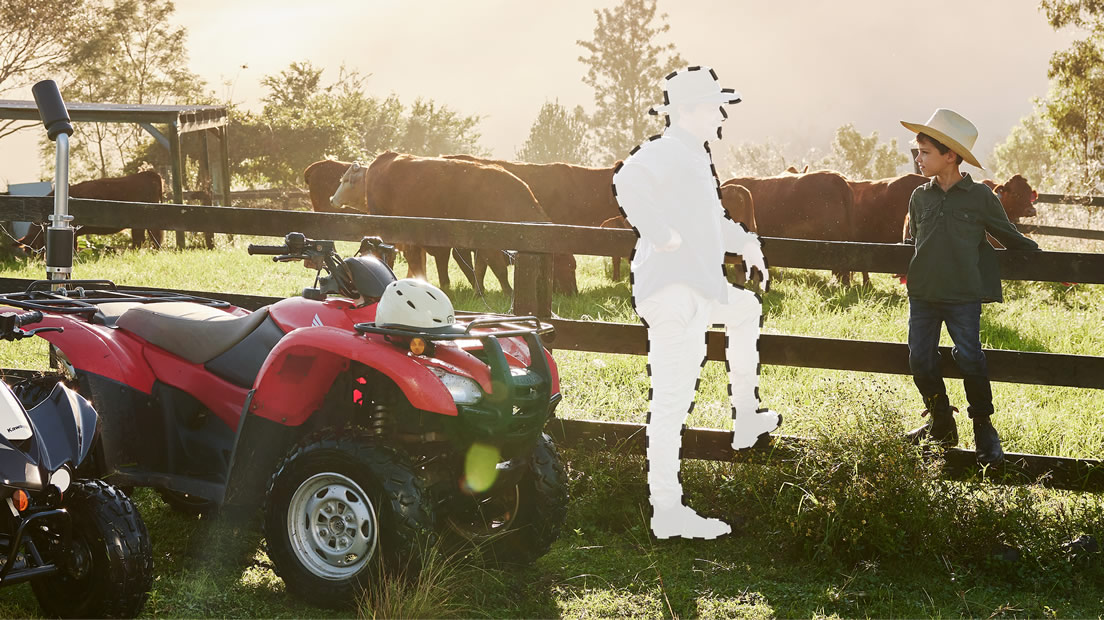
Wearing a helmet is the best way to minimise the risk of a head injury.
One in five quad bike incidents results in a head injury and head injuries cause about a third of quad bike deaths. In most of these cases, the person was not wearing a helmet.
Wearing a properly fitting helmet (compliant with AS 1698:1988 and AS/NZ 1698:2006) is the best protection you have against a head injury.
A person conducting a business or undertaking must provide safe systems of work for workers and visitors. This means ensuring quad bike riders use appropriate personal protective equipment, which can include helmets, eye protection, gloves, study footwear and clothing that covers arms and legs.
In Queensland workplaces, all individuals, including passengers, must wear securely fitted and fastened helmets while operating quad bikes.
Generally, helmets can be chosen based on the context in which a quad bike is used. Helmets that are considered appropriate for quad bikes include those compliant with AS/NZS1698, AS1698, ECE 22.05/06. An NZS 8600-02 compliant helmet may also be appropriate, but only if the speed of the quad bike does not exceed 30km/hr.
However, quad bike riders will need approved motorbike helmets if quad bikes are used in places where separate legislation already requires approved motorbike helmets. These areas extend to roads or road-related areas, state forests or timber reserves, protected areas (other than nature refuges or special wildlife reserves) and recreation areas, as administered by the Department of Transport and Main Roads and the Department of Environment, Science and Innovation.
Download a copy of this film (MP4, 21.7 MB)
Quad bikes are part of everyday life out here, but did you know quad bikes are Queensland farming's biggest killer? Wearing a helmet is the simplest thing you can do to make sure you come home safe to your family.
Authorised by the Queensland Government, William Street, Brisbane.
Choose the right helmet
Helmets come in a range of styles and sizes so it is important to find the right one for you and your needs. A helmet that is too small may be uncomfortable and not be secure and a helmet that is too large can dislodge or get knocked off in a rollover or crash.
Full-face helmet
Full-face helmets are useful where there is a higher risk of facial injuries (e.g. riding through scrub). This style of helmet can become hot if you’re wearing it for long periods, so it’s best to take regular breaks or rotate jobs between workers.
Open face helmet
Open face helmets offer similar protection to the head as full-face helmets, though little protection to the face.
Shorty style helmet
The ‘shorty’ style helmet can be suitable for tasks on rural properties such as mustering in open country as it provides head protection while still enabling good peripheral vision and hearing. It’s also lighter and cooler than a full-face helmet.
Riding on a road
To ride a quad bike in a limited way on a Queensland road, the quad bike must have conditional registration administered by the Department of Transport and Main Roads.
Quad bike riders and any passengers carried must wear an approved motorcycle helmet when the vehicle is operating on a road or road related area. The Consumer Rating and Assessment of Safety Helmets (CRASH) website rates motorcycle helmets for safety and comfort and also includes a guide to help you pick the right size.
More information
- Work Health and Safety (Quad Bikes) Amendment Regulation 2024
- Quad bikes and side-by-side vehicles
- Rural plant Code of Practice 2024 (PDF, 1.73 MB)
- When buying a new or imported second-hand quad bike, you must ensure that it complies with the Consumer Good (Quad Bikes) Safety Standard 2019, including being fitted with a rider crush protection device.
- Radio advert
- Print advert (PDF, 2.66 MB)
- Flyer (PDF, 2.17 MB)
- Poster (PDF, 8.32 MB)